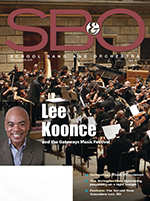One of the simplest ways of recording a band of any size is to record in stereo using just use a couple of same model microphones. That sounds easy enough, but for anyone who’s tried it, you know that there are so many ways that you can set up just these two mics that it can be mind-boggling. And they all sound different too. Let’s take a look at some of the stereo recording techniques.
Why Record in Stereo?
First of all, stereo miking is an improvement over mono miking because it provides:
- A sense of the soundfield from left to right
- A sense of depth or distance between each instrument
- A sense of distance of the ensemble from the listener
- A spatial sense of the acoustic environment: the ambience or hall reverberation
It’s hard to believe that you get all that from just two microphones, but these techniques have been used in recordings that go all the way back to the 1930s.
The Spaced Pair

Probably the simplest stereo technique is called the Spaced Pair. With the spaced-pair technique, two identical mics are placed several feet apart, aiming straight ahead toward the musical ensemble (See Figure 1). The mics can have any pickup pattern, but the omnidirectional pattern is usually used for this method. The greater the spacing between mics, the greater the stereo spread. If the spacing between mics is too far apart though, the stereo separation seems exaggerated. On the other hand, if the mics are too close together, there will be an inadequate stereo spread. It’s best to start with a distance of 10 to 12 feet between them and go from there.
ORTF

The most commonly used technique is the ORTF system, which uses two cardioids angled 110 degrees apart and spaced 7 inches (17 cm) away from each other horizontally (ORTF stands for Office de Radiodifusion Television Française or the Office of French Radio and Television Broadcasting), which is approximately the distance between each ear of a typical human head.
This method tends to provide accurate localization; that is, the instruments appear in the soundfield of the recording as they’re placed in the room or on stage. ORTF provides a much greater sense of space, since the capsules are as far apart as your ears (see Figure 2). This technique is often mistaken for the XY technique, which is much different, as you’ll soon see.
NOS

Another version of ORTF is called NOS, which stands for Nederlandshe Omroep Stichting or the Netherlands Broadcasting System. This technique places two cardioid microphones 11.8 inches apart (30 cm) at a 90-degree angle from one another (see Figure 3).
NOS has better mono compatibility than ORTF and a stronger center image as well. It’s also somewhat easier to set up than ORFT because the angle is easier to measure.
XY

Which brings us to the real X/Y configuration, which requires two identical directional microphones. Unlike what you might think, the mics shells are not crossed in an X pattern in this configuration. In fact, it’s the mic capsules that are placed as close as possible to one another in a 90-degree angle (see Figure 4). XY gives us very good imaging, but the stereo won’t seem as wide as other techniques.
The Stereo Mic
The very easiest way to record in stereo is with a stereo mic. This is actually a pair of capsules mounted in an XY configuration placed in a single housing for convenience. Because of their close proximity to one another, this method provides the simplest setup, since accessories such as a stereo bar or multiple mic stands are not required.
And More
There are yet still more stereo techniques that are either a lot more expensive to get into or have a more complex setup, such as the baffled-omni pair like the Neumann KU 100 dummy head and the home-made Jecklin disc. Then for orchestral recording there’s the Decca Tree. And then there’s the Blumlein Array and M-S technique. We won’t get into those here because we want to keep things simple, but it gives you an idea of just how extensive the subject of stereo recording can be.
Which technique works best? Great results can be had with each of the above methods, but it can take some experimentation to find just the right placement. When that happens, you’ll find you may have captured a recording that goes far beyond your expectations.
Producer/engineer Bobby Owsinski is one of the best-selling authors in the music industry. His latest, The Music Mixing Workbook, provides exercises to help you learn how to mix on any DAW. Visit Bobby’s website at bobbyowsinski.com.




















